Game Reviews
- Details
- Category: Reviews
- Hits: 4588
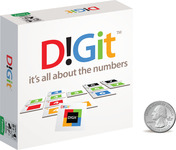 If you like Qwirkle, building patterns and matching tiles...
If you like Qwirkle, building patterns and matching tiles...
D!git —
D!git is one of a series of small tile games by Gene Mackles, designer of Gamewright's “Iota.” D!git tiles are numbered from zero to 9, and printed with five colors. The object is to create either sets (all different colors of the same numbers) or a sequences (consecutive numbers all in one color). The game is fun and fast, very portable, and very simple to teach. The wild cards give the game an unexpected level of depth, but the win condition (to run out of tiles) seems a bit too random— a bit too dependent on the luck of the draw. A game could last one turn, or go until the entire deck of tiles is gone. Still, it's a fun filler or travel game for the family road trip.
- Details
- Category: Reviews
- Hits: 2822
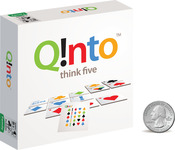 If you like Qwirkle, building patterns and matching tiles...
If you like Qwirkle, building patterns and matching tiles...
Q!nto —
Designed by Gene Mackles, published PDG Games with artwork by Gene Mackles.For 2 to 4 players ages 8 and up. Plays in about 30 minutes.
Q!into is one of a series of small tile games by Gene Mackles, designer of Gamewright's “Iota.” Q!into is very reminiscent of Qwirkle, the Spiel des Jares winner from 2013, in that the objective is to create lines of tiles that are either all matching or none matching in color or shape. The major difference here is the introduction of several types wild cards, adding a new level of decision and opportunity. It's size makes it a wonderful travel game - all you need is a table-size flat surface to play on. The age recommendation (8+) is pretty accurate, but with 3 or 4 players, this little game reveals much more depth than one would expect.
- Details
- Category: Reviews
- Hits: 3705
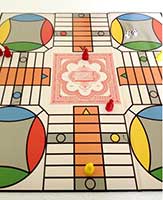 If you like Sorry, Trouble, or Aggravation (race games with ways to hinder your opponents' progress)...
If you like Sorry, Trouble, or Aggravation (race games with ways to hinder your opponents' progress)...
Pachisi —
Designer unknown, and published by dozens of companies over the past 1500 years or so.
For 2 to 4 players ages 8 and up. Plays in 30 to 60 minutes, depending on skill level.
An ancient race game from India, this is the best known of the category, having been published in some form by all the major game makers under various names. The original is still the most challenging, but you'll be playing a longer game than the commercial versions. Very fine sets can be purchased, and sets can be home-made very easily, too, if you're looking for a craft project. If you like backgammon, this is a very similar type of race game with fewer pieces but a longer track. Great fun for four, this game should be in every family's collection.
- Details
- Category: Reviews
- Hits: 3183
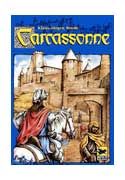 If you like working table-top puzzles, forming patterns, and board games with a prominent theme...
If you like working table-top puzzles, forming patterns, and board games with a prominent theme...
Carcassonne —
Designed by Klaus-Jürgen Wrede, published by Hans im Glück and many others, with artwork by Doris Matthäus, Anne Pätzke and Chris Quilliams.
For 2 to 5 players, ages 8 and up. Plays in about 45 minutes.
From a bag of small tiles, each player draws one and tries to fit it into an ever-growing map of roads, castles, and cloisters. Claiming ownership of completed areas gains points when the game is completed in this award-winning European game. Variations and expansions add many hours of freshness to the game as you play more and more. And you will! Take control of the roads, walled cities, and the farmland between them - but remember that you have limited resources, so make them count!
(Many expansions and enhancements are available allowing more players and more strategic options.)
- Details
- Category: Reviews
- Hits: 3007
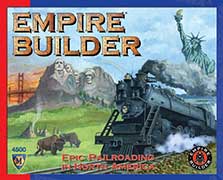 If you like Ticket to Ride, Monopoly, buying and selling and building an empire...
If you like Ticket to Ride, Monopoly, buying and selling and building an empire...
Empire Builder —
Designed by Darwin Bromley and Bill Fawcett, published by Mayfair Games, with artwork by various artists (depending on the version).
For 2 to 6 players ages 12 and up. Plays in about 2 hours.
The most popular of the “crayon rails” games, each player is the owner of a railroad company. Spending money to build railroad tracks, you connect cities which produce certain goods with other cities which want to purchase those goods. You literally use a crayon to draw the tracks on the map. Delivering goods that make you the most money is the key, and you can upgradey your locomotive to go faster or carry more goods on each trip. An excellent introduction to the “pick-up-and-deliver” style game without a lot of bookkeeping.


